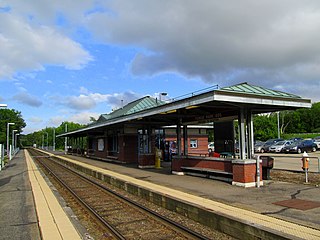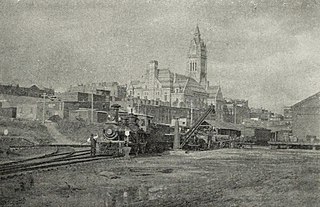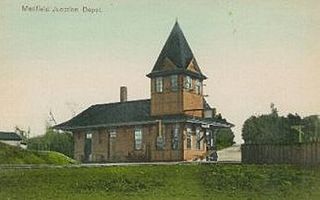Related Research Articles

The New York, New Haven and Hartford Railroad, commonly known as The Consolidated, or simply as the New Haven, was a railroad that operated principally in the New England region of the United States from 1872 to December 31, 1968. Founded by the merger of the New York and New Haven and Hartford and New Haven railroads, the company had near-total dominance of railroad traffic in Southern New England for the first half of the 20th century.

The Providence and Worcester Railroad is a Class II railroad operating 612 miles (985 km) of tracks in Rhode Island, Massachusetts, and Connecticut, as well as New York via trackage rights. The company was founded in 1844 to build a railroad between Providence, Rhode Island, and Worcester, Massachusetts, and ran its first trains in 1847. A successful railroad, the P&W subsequently expanded with a branch to East Providence, Rhode Island, and for a time leased two small Massachusetts railroads. Originally a single track, its busy mainline was double-tracked after a fatal 1853 collision in Valley Falls, Rhode Island.

The Boston and Albany Railroad was a railroad connecting Boston, Massachusetts to Albany, New York, later becoming part of the New York Central Railroad system, Conrail, and CSX Transportation. The line is currently used by CSX for freight. Passenger service is provided on the line by Amtrak, as part of their Lake Shore Limited service, and by the MBTA Commuter Rail system, which owns the section east of Worcester and operates it as its Framingham/Worcester Line.

The New York and New England Railroad (NY&NE) was a railroad connecting southern New York State with Hartford, Connecticut; Providence, Rhode Island; and Boston, Massachusetts. It operated under that name from 1873 to 1893. Prior to 1873 it was known as the Boston, Hartford and Erie Railroad, which had been formed from several smaller railroads that dated back to 1846. After a bankruptcy in 1893, the NY&NE was reorganized and briefly operated as the New England Railroad before being leased to the competing New York, New Haven and Hartford Railroad in 1898.

The Highland branch, also known as the Newton Highlands branch, was a suburban railway line in Boston, Massachusetts. It was opened by the Boston and Albany Railroad in 1886 to serve the growing community of Newton, Massachusetts. The line was closed in 1958 and sold to the Metropolitan Transit Authority (MTA), the predecessor of the current Massachusetts Bay Transportation Authority (MBTA), which reopened it in 1959 as a light rail line, now known as the D branch of the Green Line.

The Boston and Providence Railroad was a railroad company in the states of Massachusetts and Rhode Island which connected its namesake cities. It opened in two sections in 1834 and 1835 - one of the first rail lines in the United States - with a more direct route into Providence built in 1847. Branches were built to Dedham in 1834, Stoughton in 1845, and North Attleboro in 1871. It was acquired by the Old Colony Railroad in 1888, which in turn was leased by the New Haven Railroad in 1893. The line became the New Haven's primary mainline to Boston; it was realigned in Boston in 1899 during the construction of South Station, and in Pawtucket and Central Falls in 1916 for grade crossing elimination.

The Norfolk County Railroad was a railroad in Massachusetts, United States. Chartered as two different companies in 1846 and 1847, it completed a rail line between Dedham and Blackstone in 1849. A branch to Medway, Massachusetts was built in 1852. The railroad was leased by the Boston and New York Central Railroad, succeeded by the Boston and Providence Railroad and the East Thompson Railroad, before the Norfolk County Railroad returned to independent operation in 1858. In 1866, the Boston, Hartford and Erie Railroad leased the Norfolk County. The Rhode Island and Massachusetts Railroad was completed in 1877 from Franklin southward to Valley Falls, Rhode Island, and became a branch of the Norfolk County mainline. The northernmost portion of the main line from Islington to Dedham was rerouted to the east in 1881, and the original alignment abandoned two years later. The New York, New Haven and Hartford Railroad assumed operation of the Norfolk County lines in 1898.

The Housatonic Railroad is a Class III railroad operating in southwestern New England and eastern New York. It was chartered in 1983 to operate a short section of ex-New York, New Haven and Hartford Railroad in northwestern Connecticut, and has since expanded north and south, as well as west into New York State.

The Needham Line is a branch of the MBTA Commuter Rail system, running west from downtown Boston, Massachusetts through Roxbury, Jamaica Plain, Roslindale, West Roxbury, and the town of Needham. The second-shortest line of the system at just 13.7 miles (22.0 km) long, it carried 4,881 daily riders in October 2022. Unlike the MBTA's eleven other commuter rail lines, the Needham Line is not a former intercity mainline; instead, it is composed of a former branch line, a short segment of one intercity line, and a 1906-built connector.

Franklin/Dean College station is an MBTA Commuter Rail station located in Franklin, Massachusetts near Dean College. It serves the Franklin/Foxboro Line, for which it was the terminus from 1966 to 1988. The station has a mid-sized park and ride lot to serve town residents; Forge Park/495 station is intended to serve commuters from other nearby towns. The 1912-built station building still serves as a waiting hall and café, open during morning commute hours on weekdays. Franklin/Dean College station has a single side platform serving the line's single track; it is not accessible.

Forge Park/495 station is a Massachusetts Bay Transportation Authority (MBTA) commuter rail station served by the Franklin/Foxboro Line. It is located off Route 140 near Interstate 495 in Franklin, Massachusetts, United States. A park and ride station serving southwestern Boston suburbs and northeastern Rhode Island, it is the outer terminus of the Franklin/Foxboro Line. The station has two side platforms serving a single track, with an accessible mini-high platform and a station building on the south platform.

The New Haven and Northampton Railroad was a railroad originally built alongside a canal between 1847 and 1850 in Connecticut. Leased by the New York and New Haven Railroad from 1849 to 1869, the railroad expanded northwards to Massachusetts and its second namesake city in 1859. Upon the end of the lease in 1869, the company expanded further into Massachusetts, reaching as far north as Shelburne and Turners Falls.

Needham Junction station is an MBTA Commuter Rail station in Needham, Massachusetts. It serves the Needham Line. It is located on Junction Street near Chestnut Street in the southwestern part of Needham. It opened in 1906 when the New Haven Railroad built the Needham Cutoff to connect the Charles River Railroad to its main line. The station has a single side platform with an accessible mini-high platform serving the line's single track.

Needham Center station is a commuter rail station on the MBTA Commuter Rail Needham Line, located just north of Great Plain Avenue (MA-135) in downtown Needham, Massachusetts. The first station at Needham opened in 1853; it burned in 1887 and was replaced with a stone station, some of which is still in place. The station has one side platform with an accessible mini-high platform serving the line's single track.

Medfield Junction is a railway junction and former train station located in northwest Medfield, Massachusetts. It is the junction of the Framingham Secondary and the former Millis Branch. The station was open from November 1861 until April 1967.

The Fitchburg and Worcester Railroad was a railroad in Massachusetts. It was incorporated in 1840 to provide a rail connection between Fitchburg and Worcester. Service began on February 11, 1850, running 18 miles from Fitchburg through Leominster and Sterling to Sterling Junction, where it connected with the Worcester and Nashua Railroad.
The New Bedford Railroad was a railroad in Massachusetts. It was incorporated on July 1, 1873, as a merger between the New Bedford and Taunton Railroad, the Taunton Branch Railroad, and the Middleborough and Taunton Railroad. The main line ran from a junction with the Boston and Providence Railroad in Mansfield through the towns of Norton, Taunton, Berkley, Lakeville, and Freetown to the deep-water whaling port of New Bedford. The railroad also had several branches, including the former Middleborough and Taunton Railroad, which ran from Weir Village, Taunton into Middleborough through Raynham, and a shortcut to Providence via the Boston and Providence Railroad which ran from Taunton to Attleborough through Norton.
The Charles River Railroad was a railroad in the U.S. state of Massachusetts. It ran from a connection with the end of the Charles River Branch Railroad in Dover to Bellingham through the current-day towns of Medfield, Millis, and Medway.

The Millis Branch was a branch of what is now the MBTA Commuter Rail system. Branching off the still-operating Needham Line at Needham Junction, it ran through the towns of Dover, Medfield, Millis, and Medway. Due to lack of subsidies and poor ridership, the line was cut back to Millis station in April 1966, and all service ended on April 21, 1967.

The Milford Secondary is a railroad line that runs between Franklin and Milford, Massachusetts, United States.
References
- 1 2 3 4 5 6 7 8 Massachusetts. Joint Commission on the New York, New Haven & Hartford Railroad Company, ed. (1911). Report of the Board of Railroad Commissioners, the Tax Commissioner and the Bank Commissioner, sitting as a commission, relative to the assets and liabilities of the New York, New Haven & Hartford Railroad Company, Feb. 15, 1911. Boston, Mass.: Wright & Potter Printing Co. pp. 326, 420–427. LCCN 12033447. OCLC 20532802 . Retrieved 2013-01-28.
- ↑ Waskiewicz, Fred (1847). Millis Railroad History.
- ↑ "LAST RAIL LAID.: Work on Boston's Newest Railroad is Progressing Rapidly--The Air Line From West Roxbury to Needham Has Been Cut Through Solid Rock Part of the Way". Boston Daily Globe. 4 February 1906. ProQuest 500561995.
- 1 2 Humphrey, Thomas J. & Clark, Norton D. (1985). Boston's Commuter Rail: The First 150 Years. Boston Street Railway Association. p. 45. ISBN 9780685412947.
- ↑ Drury, George H. (1994). The Historical Guide to North American Railroads: Histories, Figures, and Features of more than 160 Railroads Abandoned or Merged since 1930. Waukesha, Wisconsin: Kalmbach Publishing. pp. 222–229, 248. ISBN 0-89024-072-8
- ↑ "A Brief History of Conrail". Consolidated Rail Corporation. 2003.